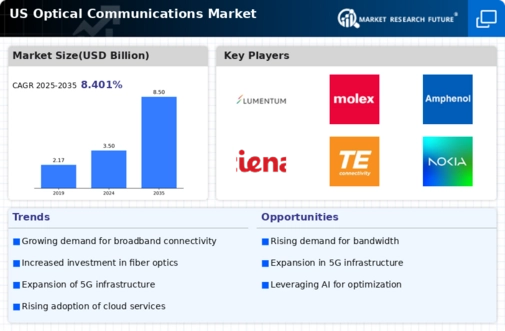Increased Focus on Data Security
The increased focus on data security is emerging as a vital driver of the optical communications market. With the rise in cyber threats and data breaches, organizations are prioritizing secure communication channels. Optical fiber networks are inherently more secure than traditional copper networks, as they are less susceptible to interception and hacking. In the US, businesses are increasingly adopting optical communication solutions to enhance their data security measures. This trend is likely to continue as organizations recognize the importance of safeguarding sensitive information. Consequently, the optical communications market is expected to experience growth as more entities seek to implement secure optical technologies.
Rising Adoption of Cloud Services
The rising adoption of cloud services is a significant driver of the optical communications market. As businesses increasingly migrate their operations to the cloud, the demand for robust and high-capacity optical networks intensifies. In the US, cloud service providers are investing heavily in optical infrastructure to support the growing volume of data traffic. Reports indicate that the cloud computing market is expected to reach $832 billion by 2025, which will likely necessitate enhanced optical communication solutions. This trend underscores the importance of optical technologies in facilitating seamless data transfer and storage, thereby propelling the growth of the optical communications market.
Growing Demand for High-Speed Internet
The increasing demand for high-speed internet services is a primary driver of the optical communications market. As consumers and businesses alike seek faster and more reliable internet connections, the need for advanced optical fiber networks becomes evident. In the US, the number of broadband subscriptions has surged, with a reported growth of approximately 10% annually. This trend necessitates the expansion of optical communication infrastructure to meet the rising data traffic. Moreover, the shift towards remote work and online services has further amplified this demand, compelling service providers to invest in optical technologies. Consequently, the optical communications market is poised for substantial growth as it adapts to these evolving consumer needs.
Technological Advancements in Optical Networks
Technological advancements play a crucial role in shaping the optical communications market. Innovations such as wavelength division multiplexing (WDM) and optical amplification have significantly enhanced data transmission capabilities. These technologies allow for the simultaneous transmission of multiple signals over a single optical fiber, thereby increasing bandwidth efficiency. In the US, the implementation of these advanced technologies has led to a marked improvement in network performance, with some systems achieving data rates exceeding 100 Gbps. As the demand for higher bandwidth continues to rise, the optical communications market is likely to benefit from ongoing research and development efforts aimed at further enhancing optical network capabilities.
Government Initiatives for Infrastructure Development
Government initiatives aimed at infrastructure development are pivotal in driving the optical communications market. In the US, various federal and state programs are designed to enhance broadband access, particularly in underserved areas. These initiatives often include funding for the deployment of optical fiber networks, which are essential for providing high-speed internet services. For instance, the Federal Communications Commission (FCC) has allocated billions of dollars to support broadband expansion projects. Such government support not only stimulates investment in optical communications but also fosters competition among service providers, ultimately benefiting consumers and contributing to the overall growth of the optical communications market.




















Leave a Comment